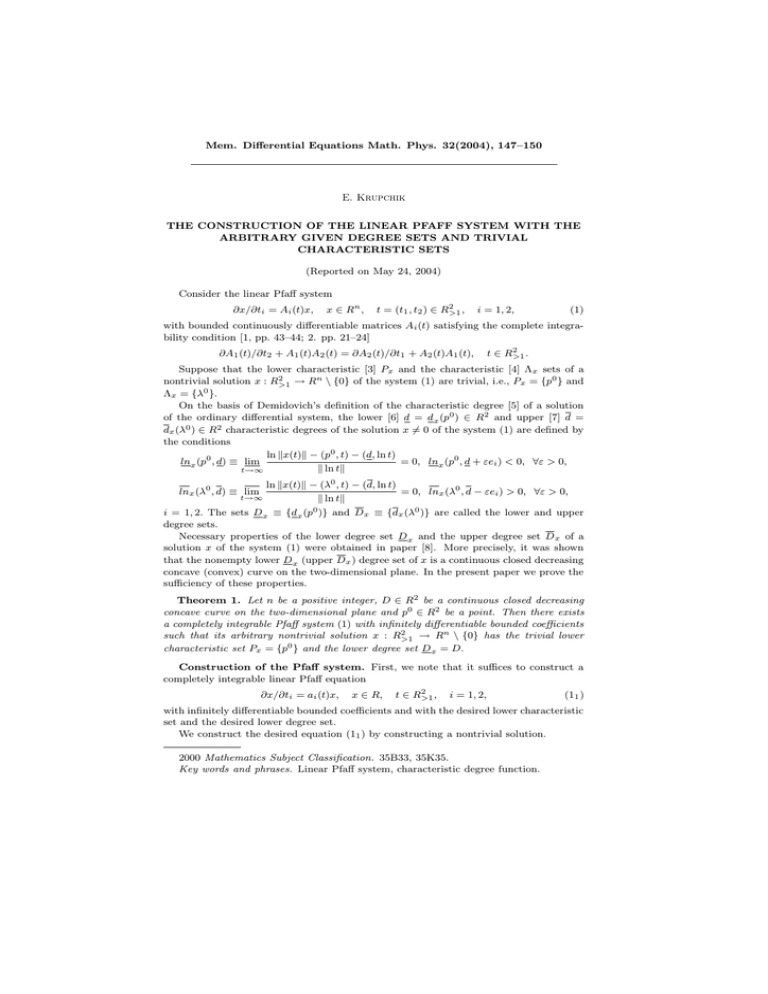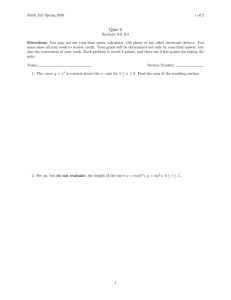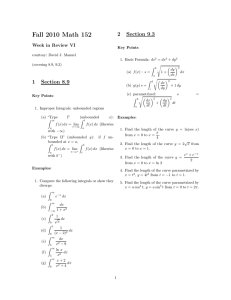Mem. Differential Equations Math. Phys. 32(2004), 147–150 E. Krupchik
advertisement

Mem. Differential Equations Math. Phys. 32(2004), 147–150
E. Krupchik
THE CONSTRUCTION OF THE LINEAR PFAFF SYSTEM WITH THE
ARBITRARY GIVEN DEGREE SETS AND TRIVIAL
CHARACTERISTIC SETS
(Reported on May 24, 2004)
Consider the linear Pfaff system
∂x/∂ti = Ai (t)x,
x ∈ Rn ,
t = (t1 , t2 ) ∈ R2>1 ,
i = 1, 2,
(1)
with bounded continuously differentiable matrices Ai (t) satisfying the complete integrability condition [1, pp. 43–44; 2. pp. 21–24]
∂A1 (t)/∂t2 + A1 (t)A2 (t) = ∂A2 (t)/∂t1 + A2 (t)A1 (t),
t ∈ R2>1 .
Suppose that the lower characteristic [3] Px and the characteristic [4] Λx sets of a
nontrivial solution x : R2>1 → Rn \ {0} of the system (1) are trivial, i.e., Px = {p0 } and
Λx = {λ0 }.
On the basis of Demidovich’s definition of the characteristic degree [5] of a solution
of the ordinary differential system, the lower [6] d = d x (p0 ) ∈ R2 and upper [7] d =
dx (λ0 ) ∈ R2 characteristic degrees of the solution x 6= 0 of the system (1) are defined by
the conditions
ln kx(t)k − (p0 , t) − (d, ln t)
lnx (p0 , d) ≡ lim
= 0, lnx (p0 , d + εei ) < 0, ∀ε > 0,
k ln tk
t→∞
lnx (λ0 , d) ≡ lim
t→∞
ln kx(t)k − (λ0 , t) − (d, ln t)
= 0, lnx (λ0 , d − εei ) > 0, ∀ε > 0,
k ln tk
i = 1, 2. The sets D x ≡ {dx (p0 )} and Dx ≡ {dx (λ0 )} are called the lower and upper
degree sets.
Necessary properties of the lower degree set D x and the upper degree set D x of a
solution x of the system (1) were obtained in paper [8]. More precisely, it was shown
that the nonempty lower D x (upper D x ) degree set of x is a continuous closed decreasing
concave (convex) curve on the two-dimensional plane. In the present paper we prove the
sufficiency of these properties.
Theorem 1. Let n be a positive integer, D ∈ R2 be a continuous closed decreasing
concave curve on the two-dimensional plane and p0 ∈ R2 be a point. Then there exists
a completely integrable Pfaff system (1) with infinitely differentiable bounded coefficients
such that its arbitrary nontrivial solution x : R2>1 → Rn \ {0} has the trivial lower
characteristic set Px = {p0 } and the lower degree set D x = D.
Construction of the Pfaff system. First, we note that it suffices to construct a
completely integrable linear Pfaff equation
∂x/∂ti = ai (t)x,
x ∈ R,
t ∈ R2>1 ,
i = 1, 2,
(11 )
with infinitely differentiable bounded coefficients and with the desired lower characteristic
set and the desired lower degree set.
We construct the desired equation (11 ) by constructing a nontrivial solution.
2000 Mathematics Subject Classification. 35B33, 35K35.
Key words and phrases. Linear Pfaff system, characteristic degree function.
148
We define the solution x of equation (11 ) by x = φψ, where ln φ(t) = (p0 , t), t ∈ R2>1 .
We define the function ψ so as to ensure that the lower characteristic set of the
resulting solution x coincides with the corresponding set Pφ = {p0 } of the function φ
and the solution x has the lower degree set D x = D.
It follows from the properties of the curve D that it necessarily has one of the following
ten forms: 1) unbounded from below, left and right, bounded from above; 2) unbounded
from below, above, left and right; 3) bounded from above and left, unbounded from below
and right; 4) unbounded from below, above and left, bounded from right; 5) bounded
from below and right, unbounded from above and left; 6) bounded from below, above
and right, unbounded from left; 7) bounded from above, left and right, unbounded from
below; 8) bounded from above and right, unbounded from below and left; 9) bounded
from above, below, left and right; 10) coinciding with a point.
1. We first suppose that the curve D has one of the forms 1) – 9). Then to
construct a function ψ realizing the lower degree set D x = D, we perform the following
partition of the curve D.
1.1. Partition of the curve D. If the curve D has the form 1) or 2), then its lth
partition Dl , l ∈ N, consists of the points ∆(i, l) ∈ D with first components ∆1 (i, l) =
(i · 21−l − l)γ, i ∈ {1, 2, . . . , l · 2l } ≡ Il ; in case 3) of the curve D with the left boundary
point ∆0 ∈ D, we construct its lth partition Dl using the points ∆(i, l) ∈ D with first
components ∆1 (i, l) = ∆01 + iγ · 2−l , i ∈ Il .
If the curve D has the form 4), then its lth partition Dl = ∪i∈Il {∆(i, l)} ⊂ D consists
of the points ∆(i, l) ∈ D with second components ∆2 (i, l) = (i · 21−l − l)γ, i ∈ Il .
In cases 5) and 6) of the curve D with the right boundary point ∆00 ∈ D, and also
in the case 8) of the curve D with the vertical asymptote d1 = ∆00
1 , we construct its lth
−l
partition Dl using the points ∆(i, l) ∈ D with first components ∆1 (i, l) = ∆00
1 − iγ · 2 ,
i ∈ Il .
In case 7) of the curve D with the left boundary point ∆0 ∈ D, its lth partition Dl
consists of the points ∆(i, l) ∈ D with second components ∆2 (i, l) = ∆02 − iγ · 2−l , i ∈ Il .
If the curve D has one of the forms 1) – 8), then we denote by il ≡ l · 2l the last
element of the set Il .
In case 9) of the curve D with the left ∆0 ∈ D and right ∆00 ∈ D boundary points,
we construct its lth partition Dl using the points ∆(i, l) ∈ D with first components
0
−(l+1) , i = 1, 2, . . . , 2l+1 − 1. We denote by I the set
∆1 (i, l) = ∆01 + (∆00
l
1 − ∆1 )i · 2
{1, 2, . . . , 2l+1 − 1} in this case and set il ≡ 2l+1 − 1.
By continuing the partition of the curve D infinitely, we obtain a countable set D ∞ =
∪l∈N ∪i∈Il {∆(i, l)} ⊂ D, which is everywhere dense in D.
We note that Dl ⊂ Dl+1 , l ∈ N.
1.2. Construction of a solution. At the ith point ∆(i, l) ∈ D, i ∈ Il , of the lth
partition, l ∈ N, we draw some straight line of support
d2 − ∆2 (i, l) = k(i, l)(d1 − ∆1 (i, l)),
k(i, l) ∈ (−∞, 0),
(d1 , d2 ) ∈ R2
to D, which does not lie below this curve. The existence of such a straight line of support
follows from the concavity of D, its decreasing character and from the fact that by
construction all points ∆(i, l) of each lth partition Dl are interior points of D. Moreover,
if a point has been used in the partition, then for all subsequent partitions, we draw the
same straight line of support at this point. This will ensure the existence of a sequence
realizing the limit lnx (p0 , d) in the definition of lower characteristic degree.
We set
Θi,l ≡ 1/|k(i, l)|,
i ∈ Il ,
∆1 (l) ≡ max{k∆(i, l)k},
i∈Il
Θl ≡ max{Θi,l },
i∈Il
Ωl ≡ min{Θi,l },
i∈Il
∆2 (l) ≡ 2−l k∆(il , l) − ∆(1, l)k−1 ,
l ∈ N.
149
To sew the different infinitely differentiable functions together into a single infinitely
differentiable function, we introduce the infinitely differentiable functions
e101 (τ ; α1 , α2 , α3 ) = e01 (τ ; α2 , α3 ) + [1 − e01 (τ ; α1 , α2 )],
e0110 (τ ; α1 , α2 , α3 , α4 ) = e01 (τ ; α1 , α2 ) · (1 − e01 (τ ; α3 , α4 )), α1 < α2 < α3 < α4 , τ ∈ R,
defined on the basis of the infinitely differentiable function [9]
(
exp{−(τ − τ1 )−2 exp[−(τ − τ2 )−2 ]}, τ ∈ (τ1 , τ2 ),
e01 (τ ; τ1 , τ2 ) =
(1 + sgn (τ − 2−1 (τ1 + τ2 )))/2,
τ ∈
/ (τ1 , τ2 ),
−∞ < τ1 < τ2 < +∞.
We define the functions ψi,l by
5τl
5τl
ln t2
; Θi,l −
, Θi,l − τl , Θi,l + τl , Θi,l +
+
ln ψi,l (t) ≡ (∆(i, l), ln t)e0110
ln t1
4
4
ln t2
+k ln tk2 e101
; Θi,l − τl , Θi,l , Θi,l + τl , t ∈ R2>1 , i ∈ Il , l ∈ N,
ln t1
τl ≡ min{1/2; Ωl /2, ∆2 (l)}.
It follows from the definition of the function ψi,l that there exists a number Tl ≥ 1
such that
ln t2
ln ψi,l (t) − (d, ln t) ≥ 0, t ∈ R2>1 \ S(i, l), S(i, l) ≡ t ∈ R2>1 : − Θi,l ≤ τl ,
ln t
1
ktk ≥ Tl , d ∈ Dl , i ∈ Il .
We split the domain of the solution x : R2>1 → R \ {0} by lines of the forms ζ(t) ≡
t1 + t2 = const into disjoint strips. By using some values η1 ≥ T1 and c ≥ exp(100), we
introduce the numbers
4(Θl +Ω−1
)
−2
2
l
νl = c(Θ6l + Ω−2
)(∆
(l)
+
1)
exp(cτ
),
α
=
η
+
ν
exp(exp i),
i,l
l
1
l
l
l
βi,l = e2 αi,l , i ∈ Il ,
We introduce the “basic” strips
ηl+1 = βil ,l + Tl+1 + 2l , l ∈ N.
Π(i, l) = {t ∈ R2>1 : βi,l ≤ ζ(t) ≡ t1 + t2 ≤ αi+1,l }, i ∈ Il \ {il } ≡ Il1 ,
Π(il , l) = {t ∈ R2>1 : βil ,l ≤ ζ(t) ≤ α1,l+1 }, l ∈ N,
the “transition” strips
P (i, l) = {t ∈ R2>1 : αi,l < ζ(t) < βi,l }, i ∈ Il , l ∈ N,
and the triangle T = {t ∈ R2>1 : ζ(t) ≤ α1,1 }.
Let us proceed to the construction of the function ψ used in the realization of the
desired lower degree set D x = D of x. First we introduce the auxiliary function ψ̃ by
ln ψ̃(t) = ln ψi,l (t) + [ln ψi+1,l (t) − ln ψi,l (t)]e01 (ln ζ(t); ln αi+1,l , ln βi+1,l ),
t ∈ Π(i, l) ∪ P (i + 1, l) ∪ Π(i + 1, l), i ∈ Il1 , l ∈ N,
ln ψ̃(t) = ln ψil ,l (t) + [ln ψ1,l+1 (t) − ln ψil ,l (t)]e01 (ln ζ(t); ln α1,l+1 , ln β1,l+1 ),
t ∈ P (1, l + 1), l ∈ N,
ln ψ̃(t) = ln ψ1,1 (t)e01 (ln ζ(t); ln α1,1 , ln β1,1 ), t ∈ T ∪ P (1, 1).
˜ t ∈ R2 in case of the curve D of one of the forms 1), 2), 4) or 8).
We set ψ(t) = ψ(t),
>1
We define the function ψ by
ln t2
ln ψ(t) = ln ψ̃(t) + [(∆0 , ln t) − ln ψ̃(t)]e01 √
;
1,
3
, t ∈ R2>1 ,
3
t1 ln t1
in case of the curve D of the forms 3) or 7) with the left boundary point ∆0 ∈ D.
We set
ln t1
ln ψ(t) = ln ψ̃(t) + [(∆00 , ln t) − ln ψ̃(t)]e01 √
;
1,
3
, t ∈ R2>1 ,
3
t2 ln t2
150
in case of the curve D of the form 5) or 6) with the right boundary point ∆00 ∈ D.
Finally, we define the function ψ by
ln t2
ln ψ(t) = ln ψ̃(t) + [(∆0 , ln t) − ln ψ̃(t)]e01 √
;
1,
3
+
3
t1 ln t1
ln t1
; 1, 3 , t ∈ R2>1 ,
+[(∆00 , ln t) − ln ψ̃(t)]e01 √
3
t2 ln t2
in case of the curve D of the form 9) with the left ∆0 ∈ D and right ∆00 ∈ D boundary
points.
2. In case 10) of the curve D consisting of one point ∆ ∈ R2 , we set ln ψ(t) =
(∆, ln t), t ∈ R2>1 .
Construction of the equation. The above-constructed function x > 0 is a solution of the Pfaff equation (11 ) with infinitely differentiable bounded coefficients ak (t) =
x−1 (t)∂x(t)/∂tk = ∂ ln x(t)/∂tk , t ∈ R2>1 , k = 1, 2, satisfying the complete integrability
condition in R2>1 and this solution has the trivial characteristic set Px = {p0 } and the
lower degree set D x = D.
Theorem 2. Let n be a positive integer, D ∈ R2 be a continuous closed decreasing
convex curve on a two-dimensional plane and λ0 ∈ R2 be a point. Then there exists a
completely integrable Pfaff system (1) with infinitely differentiable bounded coefficients
such that its arbitrary nontrivial solution x : R2>1 → Rn \{0} has the trivial characteristic
set Λx = {λ0 } and the upper degree set Dx = D.
References
1. I. V. Gaishun, Completely integrable multidimensional differential equations.
(Russian) Nauka i Tekhnika, Minsk, 1983.
2. I. V. Gaishun, Linear total differential equations. (Russian) Nauka i Tekhnika,
Minsk, 1989.
3. N. A. Izobov, On the existence of linear Pfaffian systems whose set of lower characteristic vectors has a positive plane measure. (Russian) Differentsial’nye Uravneniya
33(1997), No. 12, 1623–1630; English transl.: Differential Equations 33(1997), No. 12,
1626–1632 (1998).
4. È. I. Grudo, Characteristic vectors and sets of functions of two variables and
their fundamental properties. (Russian) Differentsial’nye Uravneniya 12(1976), No. 12,
2115–2128.
5. B. P. Demidovich, A generalization of the Ljapunov stability criterion for regular
systems. (Russian) Mat. Sb. (N.S.) 66 (108)(1965), 344–353.
6. E. N. Krupchik, Lower characteristic exponents of nontrivial solutions of Pfaffian
systems. (Russian) Differentsial’nye Uravneniya 35(1999), No. 7, 899–908; English
transl.: Differential Equations 35(1999), No. 7, 905–914 (2000).
7. P. G. Lasyi, A remark to the theory of characteristic vector degrees of solutions
of Pfaff linear systems. (Russian) Preprint IM AS BSSR: 14, Minsk, 1982.
8. N. A. Izobov and E. N. Krupchik, On necessary properties of boundary degree sets of solutions of linear Pfaffian systems. (Russian) Differentsial’nye Uravneniya
37(2001), No. 5, 616–627; English transl.: Differential Equations 37(2001), No. 5,
647–658.
9. B. R. Gelbaum and J. M. H. Olmsted, Counterexamples in analysis. HoldenDay, Inc., San Francisco, Calif.-London-Amsterdam, 1964.
Author’s address:
Belarusian State University
Skariny Avenue 4, Minsk 220050
Belarus








